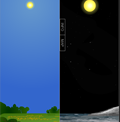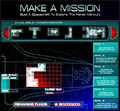Investigate the Data
How did MESSENGER discover water ice on Mercury, and where is it located? Explore data from the spacecraft and interact with maps of Mercury to discover for yourself!

Mosaic Postcards from Mercury
Mimic the process used by MESSENGER scientists and make a mosaic of Mercury using the print materials, or click on any of the Mercury mosiacs to learn more about the unique features found on and near the surface of the planet.

Mercury Mappers
Map the surface of Mercury by marking and measuring craters and linear surface features in images from the MESSENGER spacecraft. By mapping craters across the planet, we can start to piece together the global crater population and learn more about the solar system's inner-most planet.











Despite the fact that Mercury is the closest planet to our Sun, it has long been postulated that water ice could be stable in cold, permanently shadowed regions of the north and south poles. Use this interactive mapping tool to explore data collected from various sources, numerous instruments, and spanning over 40 years. Can you find the water ice deposits?